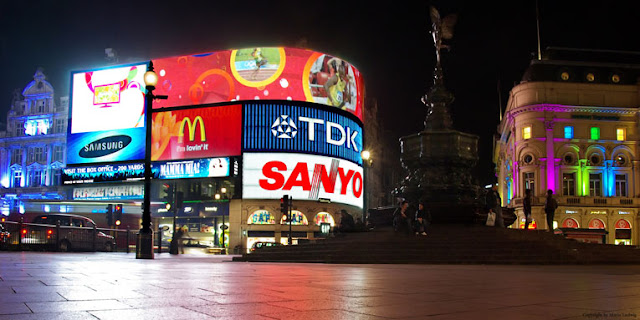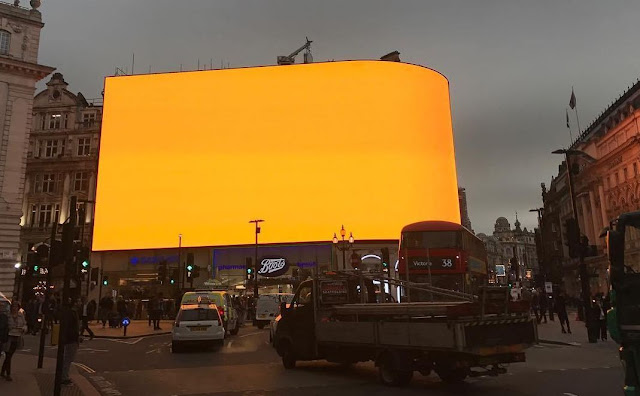1990 to today
Into the 90s and TDK replace Kodak.
On street level, Wimpy are pushed out by Burger King and Boots.
Note the new roof on the refurbished London Pavillion.
Note the new roof on the refurbished London Pavillion.
This was the last configuration which was entirely neon. Screens would gradually replace them all.
Samsung replace Panasonic with an illuminated panel rather than a neon sign, plus a message board
The Fosters panel is bought by Nescafé (under construction here)
and Coca-Cola install a screen
and Coca-Cola install a screen
The Nescafé arrive and also have a screen
McDonald's also abandon neon and install a screen
Around 2003 and Coca-Cola take the top spot. Here a printed screen masks the construction.
Their old space may await a new client, but...
Their old space may await a new client, but...
...Coca-Cola reassert their dominance over the site with a panoramic curved screen
stretching all the way to Samsung.
Budweiser replace Carlsberg.
stretching all the way to Samsung.
Budweiser replace Carlsberg.
Around 2010 and Samsung divide their panel into two parts (incorporating a screen)
and the Budweiser becomes a general advertising banner screen.
Note that the London Pivillion is lit like an echo of its coulourful past.
and the Budweiser becomes a general advertising banner screen.
Note that the London Pivillion is lit like an echo of its coulourful past.
TDK disappear and another huge screen takes its place, booked by multiple advertisers.
The top banner (held by Coca-Cola) is sub-let to other companies.
The top banner (held by Coca-Cola) is sub-let to other companies.
What is left of the Piccadilly Circus publicity surface has now become
an array of video screens (except for Sanyo).
an array of video screens (except for Sanyo).
Note the return of illuminated signs on the London Pavillion for the Believe It Or Not Museum.
The banner below McDonald's and Samsung leased to Sports Direct here.
The banner below McDonald's and Samsung leased to Sports Direct here.
Which brings us to 2013 and Sanyo finally bow out (replaced by a screen booked by Hyundai).
No traditional neon signs remained.
No traditional neon signs remained.
The jutting banner below Samsung and McDonald's is removed to allow new giant screen
which any buyers could use. All the seperate screens finally line up (fairly) neatly.
which any buyers could use. All the seperate screens finally line up (fairly) neatly.
In December 2013, a giant snow globe was constructed around it,
featuring illuminated publicity panels.
featuring illuminated publicity panels.
Unfortunately a wind storm caused the globe to deflate,
showering passers-by with artificial snow.
Here we see the Coca-Cola banner in 2014, featuring updates about the services on the London Underground (during a strike).
Flashback:
From the 19th to the 21st Century.
In 2017, the last images to be projected on the multiscreens were images of Piccadilly Circus's past.
A nice touch.
A nice touch.
All the screens were disactivated, awaiting a complete facelift.
A BBC News item about the big turn-off
In the interim, Coca-Cola occupied the space with a giant static poster display
October 2017 and the new giant single scree is activated
The moment it happened
The new giant screen permits multiple ads...
COVID-19 LOCKDOWN!
A spectacular 3D effect animation
The 2021 the agency Anomaly created these fantastic renderings
of the history of the Piccadilly neon signs for a campaign by Ancestry:
of the history of the Piccadilly neon signs for a campaign by Ancestry:






























